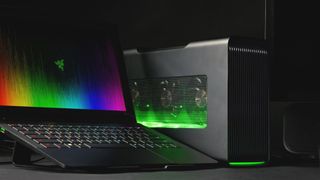AMD makes connecting a laptop to an external GPU dock as easy as plug-and-play
XConnect aims to make using an external GPU simple and seamless

AMD is aiming to simplify the process of beefing up laptops by connecting them to external graphics card enclosures, something that could prove popular this year if CES 2016 was anything to go by.
It's being done through the company's new XConnect tech, which goes live with the release of AMD's latest Radeon graphics driver (v16.2.2) today.
To make it work, you hook up your external Radeon (R9 300 and Fury series) GPU — housed in its external docking station — to your Windows 10 laptop via Thunderbolt 3, which delivers up to 40Gbps of bandwidth.
Thanks to a management interface built into the Radeon driver, connecting and disconnecting it from that point on is a simple plug-and-play process similar to removing a USB stick.
The system offers further flexibility in that you can game on the notebook display, or pipe the output to an external monitor if you prefer.

Co-developed
AMD has developed XConnect in conjunction with Intel and Razer, and indeed the first laptop to sport XConnect (the system's BIOS must be configured to support the tech, as well as having a Thunderbolt 3 port, of course) will be the Razer Blade Stealth 12.5-inch Ultrabook.
It's powered by an Intel Core i7-6500U CPU and is 13.1mm thin, boasting two options on the touchscreen display: A resolution of 3,840 x 2,160 or 2,560 x 1,440.
Get daily insight, inspiration and deals in your inbox
Get the hottest deals available in your inbox plus news, reviews, opinion, analysis and more from the TechRadar team.
The Stealth hooks up with Razer's Core eGFX external graphics enclosure (pictured top) complete with Radeon card which can be easily upgraded (you get 375W worth of juice in terms of the maximum power that can be supplied).
Darren is a freelancer writing news and features for TechRadar (and occasionally T3) across a broad range of computing topics including CPUs, GPUs, various other hardware, VPNs, antivirus and more. He has written about tech for the best part of three decades, and writes books in his spare time (his debut novel - 'I Know What You Did Last Supper' - was published by Hachette UK in 2013).
Most Popular

